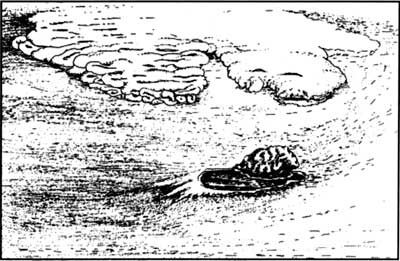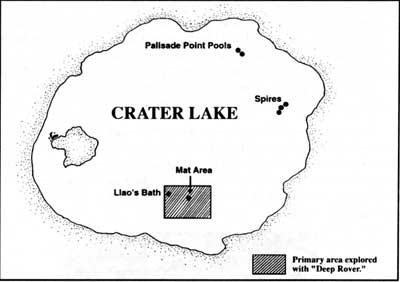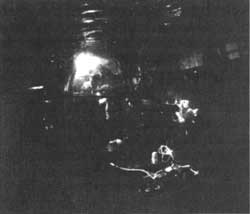Another interesting discovery was the presence of discrete pools of saline water on the lake floor that had a distinct blue color. The first “blue pool” discovered was named Llao’s Bath by Jack Dymond, after the legendary spirit of the lake. The pool resembled an oblong bath, 10 to 13 feet long and 3 to 5 feet across. It appeared to be elevated on one side by precipitates, and was surrounded by golden-colored bacteria. This pool and others like it are composed of hydrothermal water with salt content as much as ten times higher than the surrounding lake water. The presence of the salts makes the liquid in the pool heavier than lake water, and the pools appear blue because of the optical properties of the chemically enriched fluids. In general, many chemical indicators of hydrothermal origin were detected in fluids taken from the pools. In the most anomalous pool fluids, manganese was enriched by as much as a million times and Radon (222Rn) was enriched 100,000 times over typical lake values. Helium-3, perhaps the most distinctive indicator of a magmatic heat source, was enriched 500 times more than values for water in equilibrium with the atmosphere.
 Llao’s Bath and “brain” mat complex. Llao’s Bath is in the foreground.
Llao’s Bath and “brain” mat complex. Llao’s Bath is in the foreground.
Drawing by Kathryn Brooksforce.
We were surprised to find another area of hydrothermal activity below the Palisades along the northeast caldera wall during one of the dives. Small stream-like features originated from underneath boulders or rock outcrops along the base of the caldera wall. The stream-like channels were two to three inches in width and equally as deep. Although no flow was observed at the time, the channels formed networks which exhibited classic erosional flow patterns. The channels were lined with brilliant gold bacteria and often terminated down slope in a series of blue pools. Twenty or more pools with associated islands, embayments, and delta-like features were observed in an area approximately 160 feet wide and 320 feet long.
Along the base of the east wall below Skell Head, remnant spires served as a record of past hydrothermal activity. Over 30 feet high, the spires had a chemistry indicative of a hydrothermal origin and a morphology consistent with underwater formation. Similar spires have been observed around active, high-temperature, hydrothermal sources in oceans around the world. The spires form when chemically rich hydrothermal fluids come in contact with cold ambient water and the chemicals precipitate out of solution to form chimneys around the vents.
In addition to the hydrothermal studies, Deep Rover provided a unique opportunity to survey the lake floor for plants and animals. Previous biological studies of Crater Lake were limited to sampling from a surface boat, collections along the shoreline, or shallow dives using SCUBA gear. During the submersible studies, several unusual and interesting biological discoveries were made. A thick band of moss, Drepanocladus aduncus, encircled the lake, and was observed growing at depths from 85 to 460 feet. It hung like icicles on vertical cliffs and formed thick lush fields on the gentler slopes around Wizard Island. The remarkable lower depth limit of 460 feet was due to the ability of light to penetrate deep into Crater Lake’s clear water.
Animals were found living in Crater Lake’s deepest basin at 1,932 feet below the surface. This was particularly fascinating because of the extreme water pressure that these animals must sustain to live at this depth. The deep-water animals were found at relatively low densities and included flatworms, nematodes, earthworms, copepods, ostracods, and the midge fly Heterotrissocladius. Many specimens survived the rapid pressure change during the retrieval from the lake floor and lived in the laboratory for several weeks after collection.
The geological studies conducted with Deep Rover expanded our knowledge of the eruptive history of Mount Mazama. Most of the rocks sampled from the caldera walls were lava flows which came from Mount Mazama, but a few samples collected from greater depth were rocks which predate Mount Mazama. These studies also provided new information on postcaldera volcanism by indicating which lava flows occurred beneath lake water and which erupted before the lake filled. Flows that formed the central platform, located east of Wizard Island, came about prior to the lake level reaching them. Merriam Cone and most of the submerged portion of Wizard Island formed beneath the water surface when the lake was approximately 250 feet below its present level. All of the postcaldera rocks sampled were andesite, with the exception of those from a small rhyodacite dome on the east flank of Wizard Island. The rhyodacite dome rises to approximately 100 feet of the lake surface and may have formed when the lake was close to its present level. The dome is the youngest volcanic feature known, with an age of approximately 5,000 years before present.
The dives were not without an element of mystery. I observed craters with a diameter of two to three inches in the deepest part of the lake. The origin of these craters is still unknown, though they may have formed from biological activity or from processes associated with gas and/or fluid release from the lake sediments. With so much to explore, it was hard to accept that the voltage remaining in the submarine’s main batteries dictated the length of each dive. At the end of a typical six-hour dive, the temperature of the submarine was a comfortable 68 °F. Tired but still operating on adrenalin, I stretched the length of the dives out as long as possible. When the dive was over, air was added to the submarine’s ballast tank allowing Deep Rover to slowly leave the lake floor. This was the first opportunity to relax during a dive. The ascent into natural light was peaceful. As Deep Rover rose and the water pressure decreased, air in the ballast tank would expand and spill out the base of the submarine rising around the sphere in a silvery blue veil of bubbles. Once on the surface, a crew of scientists and technicians quickly descended upon the submersible to secure and preserve the invaluable samples.
Deep Rover opened a brief and rare window of opportunity to view and explore secrets hidden at the depths of Crater Lake, yet less than two percent of the lake floor was explored. Discoveries from the submersible program not only provided valuable information on lake ecology and evolution important to understanding and protecting the lake. The program also documented previously unrecorded lush fields of moss, animals living at the bottom of the lake, and hydrothermal streams and vivid blue pools that supported exotic gardens of yellow-gold bacteria. The unusual scenes on the lake floor are consistent with the aerial view that visitors experience today; a sight only slightly altered from that which inspired people a century ago to dedicate themselves toward the establishment of Crater Lake National Park.
The author would like to thank cooperative biological investigators Gary L. Larson, C.D. McIntire, and Harry K Phinney, principal geological investigator Charles R. Bacon, and principal hydrothermal investigators Robert Collier and Jack Dymond. This program would not have been successful without the tireless work of submersible and scientific technical teams, and the staff of Crater Lake National Park.
References
C.R. Bacon and M.A. Lamphere, “The geologic setting of Crater Lake, Oregon,” pp. 19-27 in E.T. Drake, et al. (eds.), Crater Lake: An Ecosystem Study. San Francisco: Pacific Division, American Association for the Advancement of Science, 1990.
R.W. Collier, et al. Studies of Hydrothermal Processes in Crater Lake, Oregon. College of Oceanography Report #90 7. Corvallis, OR: Oregon State University, 1991.
J. Dymond, et al. “Bacteria mats from Crater Lake, Oregon and their relationship to possible deep-lake hydrothermal venting,” Nature 342(1989), pp. 673-675.
C.D. Mclntire, et al. “Survey of deep-water benthic communities,” pp. 661-679 in G.L. Larson, et al. (eds.), pp. 661-679 in G.L. Larson, et al. (eds.), Crater Lake Limnological Studies Final Report. Technical Report NPS/PNROSU/NRTR-93/ 03. Seattle: USDI, NPS, Pacific Northwest Region, 1993.
C.H. Nelson, et al., “The volcanic, sedimentologic, and paleolimnologic history of the Crater Lake caldera floor, Oregon: Evidence for small caldera evolution,” Geological Society of America Bulletin 106(May 1994), pp. 684-704.
Mark Buktenica has worked at Crater Lake since 1985 and is currently the park’s aquatic ecologist.



